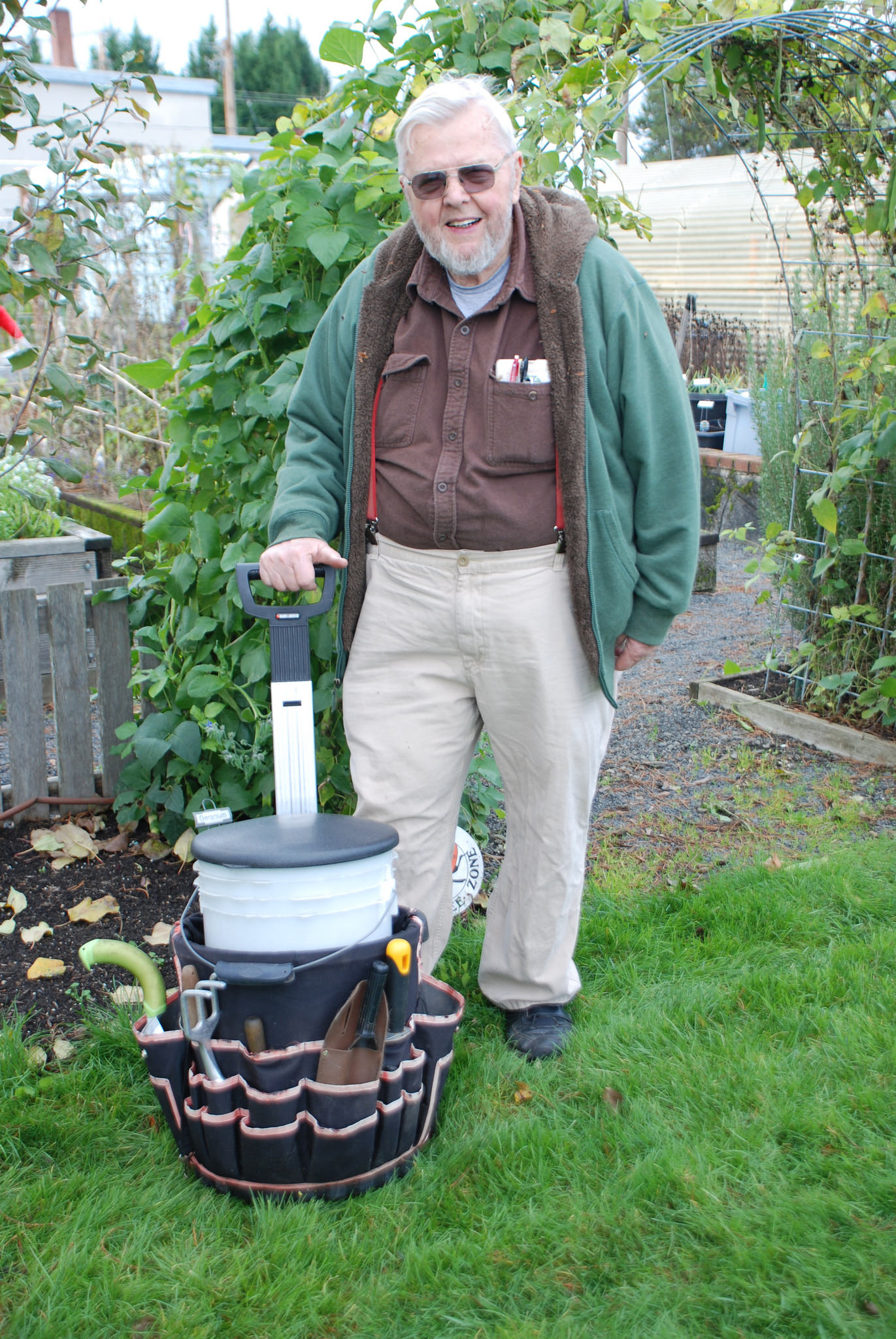When it comes time to garden, which is almost every day, 83-year-old Jerry Anderson stretches to warm up his muscles, picks up an ergonomic trowel and settles himself on a bucket in front of one of his raised beds. He sees no reason to ever stop his routine.
“I’ve got eight dahlia beds built so I can put one on top of another,” said Anderson, who has been an Oregon State University master gardener for 21 years. “That way if I’m in a scooter someday, I can still garden.”
On the days he’s not gardening, Anderson tends to the Master Gardener Demonstration Garden at the Washington County Fairplex. Or, he delivers talks as part of a team about adaptive gardening for those who, like him, have a reason to alter their methods to fit situations like being in a wheelchair, struggling with lung problems or having arthritis.
Anderson, who was a vocational rehabilitation counselor for 20 years before he retired, said gardeners without challenges can benefit from adaptive gardening as well. Warming up, taking breaks and using ergonomic tools applies to everyone.
At the demonstration garden, various techniques are displayed, including a variety of raised beds, containers and vertical gardening options.
Anderson offers his tips for gardening made easier:
Take advantage of raised beds. They can be anything from traditional beds made of wood (regular or manufactured), concrete blocks or thick pavers. Make them 3 to 4 feet wide so you can easily reach into the middle. Anderson said kits for raised beds are often available at Bi-Mart, Wilco and Coastal Farm and Ranch.
- Recommended heights for raised beds are 36 to 40 inches for ambulant men; 25 to 30 for men who are seated but can get up; and a maximum of 24 inches for men in wheelchairs. For women, build beds 25 to 36 for those who can stand; 27 for those who are seated but can stand, and a maximum of 24 inches for those who are in wheelchairs.
Garden in containers. They can be placed on the ground or tables, whatever is a convenient height. Containers are easier to weed and water than gardens in the ground. They also take much less work to fill with soil than adding compost to in-ground gardens. Containers with wheels are easy to move around. Anderson likes to use water troughs made of black plastic that warm the soil sooner in spring and allow for a longer gardening season. Be sure to drill holes in the bottom. There are also galvanized versions. Look for them at feed and seed stores.
Use a pulley system for hanging baskets, which reduces the weight of the basket by half, and allows it to be pulled down for watering and planting. Find them at larger garden centers or online.
Use ergonomic tools:
- Women should seek out tools made for smaller hands.
- If needed to protect wrists, look for tools with braces.
- Choose tools with curved handles and indentations for fingers. Buy tools with padded handles or modify them with water pipe insulation, bicycle handles or tape used to wrap golf clubs.
- Anderson is partial to a tool called a Trak that has a trowel at one end and a hand rake at the other, with an ergonomic handle in the middle.
Sit on a bucket or seat made for gardening.
Buy a kneeler with handles that will help you get up. There are some versions that can be turned over and used as a seat.
Pick the smallest watering can for your abilities – a 1- or 2-gallon instead of the usual 3.
Warm up and take breaks. Anderson periodically stops pruning to sharpen his pruners with a diamond file for fish hooks to give himself a breather.
Keep pruners sharp to make cutting easier. Use a sheath to protect yourself from accidently sitting or kneeling on them.
Try vertical gardening. Build or buy a trellis that’s at an appropriate height for you. At the demonstration garden, you can see an example of one that is made of PVC pipe and netting and hinged at the bottom so it can be pulled down for harvest.
Start small. Biting off more than you can handle means more work and more chance of overdoing it.
Consider succession gardening. Planting crops at staggered dates keeps you from being overwhelmed. Plants will come ripe at different times so you’ll do less work all at once. “You can do a little bit at a time,” Anderson said.
Experiment with square foot gardening, an intensive method that uses the appropriate amount of plants per a certain size block of garden. “You know the plants’ requirements and plant them according to that,” Anderson said. “So instead of having a 6-foot-long row of carrots that takes forever to thin and weed, you have 16 carrots in an easy-to-maintain square. It breaks the task down.” Blocks are planted in succession rather than all at once to keep maintenance at a reasonable level.
Make wide paths if you use a wheelchair or scooter or if there is the possibility that you may someday.
Have garden and tools close to the house so you don’t have to walk far.
Refer to eight OSU publications on making gardening easier for those in a wide range of situations from arthritis to lung and heart problems.
Visit the demonstration garden at the Washington County Fairplex in Hillsboro if you’re in the area,. Master Gardeners are there every Tuesday from 9 a.m. to noon year round.
Pick up one of the books Anderson recommends: “Raised Bed Revolution, Tara Nolan; “The Vegetable Gardener’s Container Bible,” Edward C. Smith; “All New Square Foot Gardening II,” Mel Bartholomew; and “Slow Gardening” Felder Rushing.

